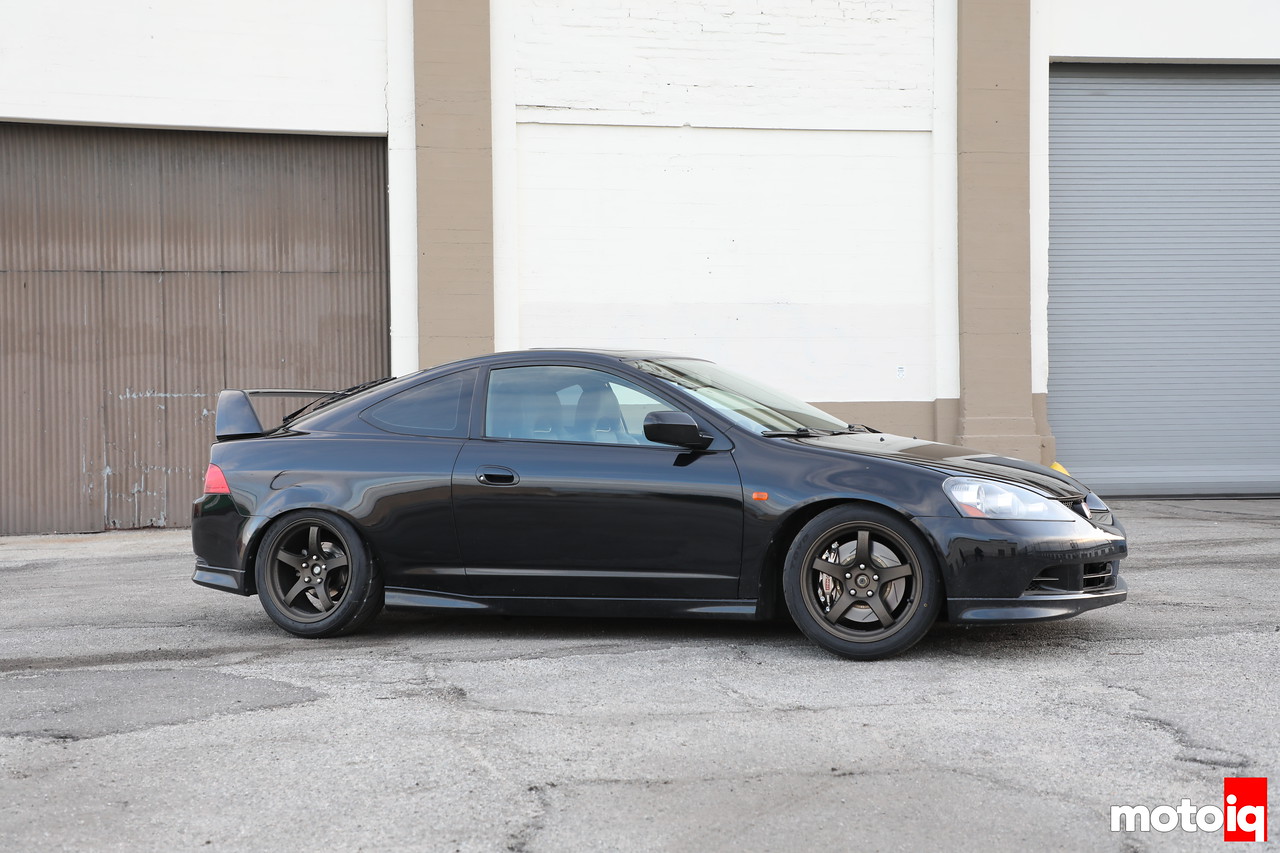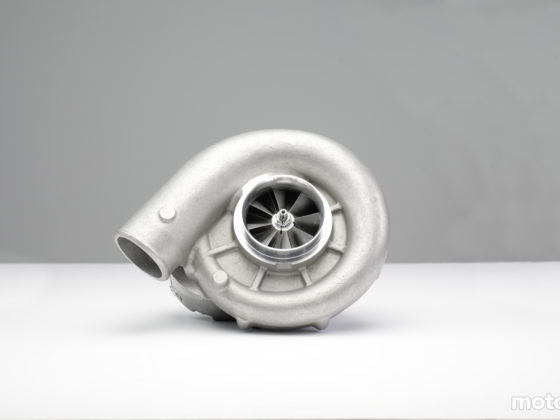
We used a Canton breather tank with a filter part number 23-032 on the crankcase vent. The breather tank has a quick drain on the bottom which is really handy.

We made a bracket and mounted it here in the engine compartment.

It looks nice and tidy.

To make room for the cold air intake we made a new bracket for a compact and super light Antigravity battery part number ATX20-HD. The battery only weighs 5 lbs saving about 30 lbs off the front of the car and has enough power to easily start the engine.

Next, it was on to Church Aumtotive Testing to have Shawn Church tune our Hondata ECU.

Church uses huge fans to keep the engine bay, coolant and under-car temps under control.




43 comments
how do you decide when to go with a vent to atmosphere crank case ventilation and when to do a sealed system?
Well, a mass airflow meter car should always have a recirculating system. Speed density you can do what you want. A track driven car might need a vent to atmosphere system because it is run at high loads and RPM a lot and thus have to deal with more blowby.
if I have a track car with a recirculating system (mass airflow), what would indicate that switching to a vented system would be a good idea? Lots of oil in my catch cans? Anything else?
40+ hp from just a cat :freak:
NA motors with big cams are really sensitive to backpressure.
How close to the collector was the cat placed?
Pretty close to the end of the megaphone.
Can you give us any more details on the cat? IE: diameter, CPI?
I’m really surprised to see that much of a difference, but obviously it messes with the reflected wave too (I remember that being mentioned in the Porsche build too)
Magnaflow P/N 59959 inlet and outlet 3″ body diameter 4″. The cell count is not specified.
Happy to see this car finally hit the dyno. I went and bought my first Honda, a 2010 Si coupe, partly because of the first articles of this project back in november ( and because my winter car died ). On paper they are very similar cars but the RSX is way prettier, I do like the close ratio gears on the Si though.
Does the DC5 share any of the suspension and steering problems of the 7th gen civic?
The DC5 has all of the issues as the EP3. It does have normal power steering so that helps.
Finally makes sense as to why RTR went to the TSX instead of the RSX.
Ooof, well my 8th gen isn’t much better, the drivetrain is 90% of the reason I bought it, I’m not swapping my miata as a summer car.
I might do sway bars and coilovers to help with the handling. The steering feel is tragic but I’m not sure there is anything I can do about it.
@Nicolas, I’d recommend doing the Hondata Flashpro ASAP. Buddy of mine has a 2008 Civic SI and the throttle hang when shifting is horrendous. Of course, the Flashpro does a great job improving throttle response and bumping up power a bit. Half the reason I got the Hondata Kpro for Project S2000 was to get rid of the VTEC torque spike. So annoying.
Thanks Khiem, reason more to got to a Hondata. I was already looking into it to lower the Vtech RPM.
Mike, does anybody sell a black anodized aluminum radiator? I would think that a black radiator would be far superior at absorbing heat than a reflective one.
Actually, I’m really surprised that they don’t have black anodized radiators in motorsports like F1.
If anybody can do a ‘back-of-the-envelope’ calc, I would love to see it. I guess you would just need to know the surface area of a typical radiator. Too lazy to do it myself, but if I was doing an ultimate ‘motorsport’ build and they sold black radiators, I would absolutely study the price difference and see if it was worth it.
From my Heat Xfer course in college:
“Black objects, on the other hand, generally absorb and emit radiation very well, and have emissivities close to 1. An object with ε = 1 is called a perfect blackbody. The best absorbers are also the best emitters. Black objects heat up faster than shiny ones, but they cool down faster too.”
Not as far as I know. Someone told me but I don’t have data that anodizing reduces heat transfer.
Yes, the oxide layer does reduce the thermal conductivity of aluminium.
Black body radiation is also about radiation – it doesn’t have any significant effect on convection which is the dominant heat transfer mechanism going on here.
the way I understand it, black only helps heat transfer when the only acting factor on it is a temperature difference. as soon as you introduce other factors, such as air moving through the radiator, the color emissivity is so small it becomes irrelevant.
Another thing to keep in mind, is color emissivity goes both ways, so if you have stuff thats hotter than the radiator (turbo, headers, etc), it’ll absorb heat faster too.
Just FYI, but I was thinking this would probably be more of a benefit in motorsports. In F1, cars sit on the grid with no movement for a significant amount of time. I would imagine that any kind of improvement would be worth while. You could also just paint the radiator black, but I’ve never seen even that in F1.
Beautiful job! You guys have the best toys.
I ran some general numbers and came up with a thermal resistance increase from anodizing of the radiator of about 2% at max power for the car in this article. This translates to a coolant temperature increase of about 1 degC over a new unanodized radiator and is probably comparable to the increase in thermal resistance after the radiator surface has oxidized for a year or so. The reason for this result is that the thickness of the anodizing layer is small (~0.1mm) so, even with poor thermal conductivity, the impact is small due to the thin layer and the large effective area of radiator cooling fins that it is spread over.
Did you try to model black anodizing?
Of course, it’s probably not worth it for the typical enthusiast. But, in motorsports like F1, 1-2% is actually significant. It only prove the point that a motorsport radiator should be either painted black, or anodized black. I would probably get some serious kudos if I was working for an F1 team, because 2% can be reduced to a significant lap-time improvent.
In racing, strangely enough, it’s the littlest detaiils that have the most benefit.
No, I just used the thermal conductivity of alumina. As one of the previous commenters said the radiative effects of black are small compared to the conduction; there may even be some extra heat absorbed from the engine because some engine parts are hotter than the radiator though the fan and shroud will block most of it. If the anodizing is colored with a dye, the thermal conductivity of the anodizing layer will be largely unaffected; if the black has a carbon content the thermal conductivity of the anodizing layer will be increased by an amount that depends on a number of factors and the offset from no anodizing will be reduced. Uncolored/ no carbon loading is the worst case.
Was the PCV ran back into the intake?
Yes.
To settle the point I ran the numbers for black radiative cooling and came up with 0.01% of the dissipated power in the radiator. assuming that 50% of the radiator intake surface was emitting.
So it would be a valid thing, protecting the radiator with an anodic film and not hurting its effectiveness.
Motorpsorts are like anything else in life. A small initial change can result an a huge difference when it is multiplied in time. Honestly, there are aeronatical enginners chasing fractions of a second on a lap. Nothing is wasted in this endeavor. Every improvment is important over the course of a 2hr race, those improvements are amplified non-linearly.
Adding a layer of anodizing reduces thermal transfer from convection (i.e. heat removal to the air flowing through the radiator) by about 2% at max output power for the car in your article. There’s a reduction in the reduction of about 0.01% from radiation from the front of the radiator, leaving about 1.99% degradation. The net result is still a small reduction in radiator performance compared to what it will do when it’s new and shiny; it will probably perform about the same as it will after the car has been in use for some time without anodizing and the radiator is no longer shiny but grayer and oxidized. Anodizing also has a smaller coefficient of thermal expansion than aluminum, which means it cracks when cycled over the temperature ranges seen in car radiators. So you’ll end up with a coating that has cracks in it and atmospheric oxidation growing underneath the anodizing in patches, further reducing radiator effectiveness. Will it make any practical difference? Probably not for a street car unless you’re pushing the cooling system to it’s limits, but spending money on something that degrades performance and will look bad after normal use doesn’t seem very useful (except, maybe, for a show car that is hardly run).
As the last commenter said, motorsports are a different matter. All the pictures that I could find of F1 car cooling systems use bare aluminum radiators.
With some things, observation provides the answer without having to do any math. If F1 cars and LMP cars don’t have black radiators, it’s because it doesn’t help. Why does it not help? Possibly the process of creating the black surface hurts convection heat transfer more than gaining from radiation. And/or, the surrounding environment isn’t cold enough. Or worse, the surrounding environment is hotter than the radiators as could be the case with tightly packaged engine bays with 1000degC exhaust manifolds and making the heat exchangers black actually hurts performance.
Oh yeah, MotoGP bikes also do not have black radiators. Again, the absolute pinnacle of racing with extremely high budgets.
The part number XF0-KST-UNV-350 appears to be for the K Tuned thermostat housing. Any chance you could double check the part number for the Varex muffler?
The muffler is XFO-VMK11-300
Thanks!
303whp NA from a 2.4L street engine on pump gas is just bonkers. Imagine telling people you would be able to do this 20 years ago. They would not believe it could be street-able in any way.
The amazing thing is this is all easily available off the shelf parts! No engineering, experimental specs and months of waiting for special stuff!
It still seems bonkers!
At least it appears to be a hub dyno so we don’t have the tyre/roller losses that are normally more significant than transmission losses.
Does the dyno has a means of calibration that’s done regularly?
If not, has the build or similar been on a calibrated engine dyno?
It’s a result that you should be proud of with any pump style fuel.
It’s calibrated to produce close to what a dynojet reads
Which head package to buy drag cartel has like 7 of them plus they don’t reply to emails
Street Strip series